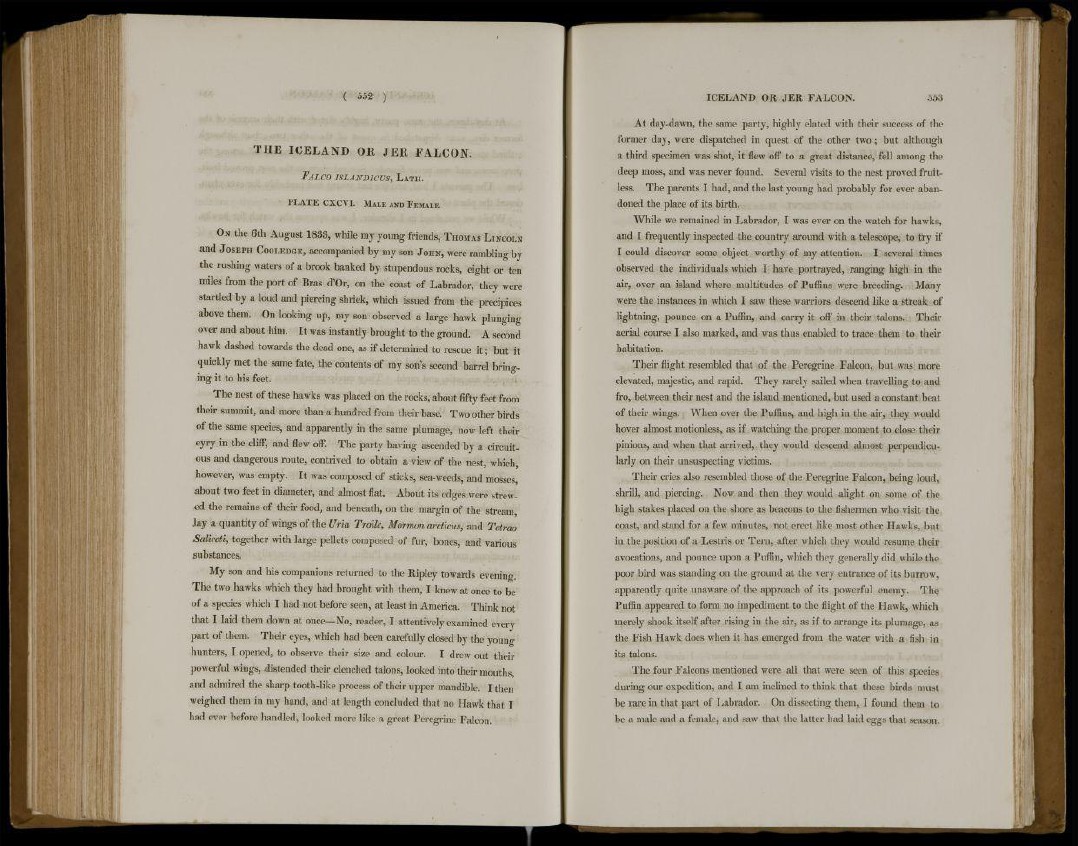
( 552 )
T H E I C E L A N D O R J E R F A L C O N .
FALCO ISLANDICUS, LATH.
PLATE C X C V I . MALE AND FEMALE.
ON the 6th August 1833, while my young friends, THOMAS LINCOLN
and JOSEPH COOLEDGE, accompanied by my son JOHN, were rambling by
the rushing waters of a brook banked by stupendous rocks, eight or ten
miles from the port of Bras d'Or, on the coast of Labrador, they were
startled by a loud and piercing shriek, which issued from the precipices
above them. On looking up, my son observed a large hawk plunging
over and about him. It was instantly brought to the ground. A second
hawk dashed towards the dead one, as if determined to rescue it; but it
quickly met the same fate, the contents of my son's second barrel bringing
it to his feet.
The nest of these hawks was placed on the rocks, about fifty feet from
their summit, and more than a hundred from their base. Two other birds
of the same species, and apparently in the same plumage, now left their
eyry in the cliff, and flew off. The party having ascended by a circuitous
and dangerous route, contrived to obtain a view of the nest, which,
however, was empty. It was composed of sticks, sea-weeds, and mosses,
about two feet in diameter, and almost flat. About its edges were strewed
the remains of their food, and beneath, on the margin of the stream,
lay a quantity of wings of the Uria Troile, Mormon arcticus, and Tetrao
Saliceti, together with large pellets composed of fur, bones, and various
substances.
My son and his companions returned to the Ripley towards evening.
The two hawks which they had brought with them, I knew at once to be
of a species which I had not before seen, at least in America. Think not
that I laid them down at once—No, reader, I attentively examined every
part of them. Their eyes, which had been carefully closed by the young
hunters, I opened, to observe their size and colour. I drew out their
powerful wings, distended their clenched talons, looked into their mouths,
and admired the sharp tooth-like process of their upper mandible. I then
weighed them in my hand, and at length concluded that no Hawk that I
had ever before handled, looked more like a great Peregrine Falcon.
ICELAND OR JER FALCON. 553
At day-dawn, the same party, highly elated with their success of the
former day, were dispatched in quest of the other two; but although
a third specimen was shot, it flew off to a great distance, fell among the
deep moss, and was never found. Several visits to the nest proved fruitless.
The parents I had, and the last young had probably for ever abandoned
the place of its birth.
While we remained in Labrador, I was ever on the watch for hawks,
and I frequently inspected the country around with a telescope, to try if
I could discover some object worthy of my attention. I several times
observed the individuals which I have portrayed, ranging high in the
air, over an island where multitudes of Puffins were breeding. Many
were the instances in which I saw these warriors descend like a streak of
lightning, pounce on a Puffin, and carry it off in their talons. Their
aerial course I also marked, and was thus enabled to trace them to their
habitation.
Their flight resembled that of the Peregrine Falcon, but was more
elevated, majestic, and rapid. They rarely sailed when travelling to and
fro, between their nest and the island mentioned, but used a constant beat
of their wings. When over the Puffins, and high in the air, they would
hover almost motionless, as if watching the proper moment to close their
pinions, and when that arrived, they would descend almost perpendicularly
on their unsuspecting victims.
Their cries also resembled those of the Peregrine Falcon, being loud,
shrill, and piercing. Now and then they would alight on some of the
high stakes placed on the shore as beacons to the fishermen who visit the
coast, and stand for a few minutes, not erect like most other Hawks, but
in the position of a Lestris or Tern, after which they would resume their
avocations, and pounce upon a Puffin, which they generally did while the
poor bird was standing on the ground at the very entrance of its burrow,
apparently quite unaware of the approach of its powerful enemy. The
Puffin appeared to form no impediment to the flight of the Hawk, which
merely shook itself after rising in the air, as if to arrange its plumage, as
the Fish Hawk does when it has emerged from the water with a fish in
its talons.
The four Falcons mentioned were all that were seen of this species
during our expedition, and I am inclined to think that these birds must
be rare in that part of Labrador. On dissecting them, I found them to
be a male and a female, and saw that the latter had laid eggs that season.